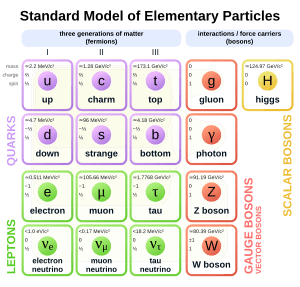Quantum chromodynamics facts for kids
Quantum chromodynamics (QCD) is a special theory in physics. It helps us understand the strong interaction, which is the strongest force in the universe! This force acts between tiny particles called quarks and gluons. These quarks and gluons are the fundamental building blocks that make up bigger particles like the protons and neutrons. Protons and neutrons are found inside the center of every atom, and they make up almost everything you see around you!
Contents
What is Quantum Chromodynamics?
Quantum Chromodynamics, or QCD for short, is the theory that describes how quarks and gluons interact. Think of it as the rulebook for the strong force. This force is incredibly powerful. It's what holds the nucleus of an atom together, even though the protons inside want to push each other away because they have the same electric charge.
The Strong Force: Nature's Strongest Glue
There are four basic forces in nature: gravity, electromagnetism, the weak nuclear force, and the strong nuclear force. The strong force is by far the most powerful. It's like a super-strong glue that binds quarks together to form protons and neutrons. Without this force, atoms wouldn't exist, and neither would you!
Quarks: The Tiny Building Blocks
Quarks are some of the smallest particles we know. They are considered "fundamental," meaning they aren't made of anything smaller. There are six different types, or "flavors," of quarks:
- Up quark
- Down quark
- Charm quark
- Strange quark
- Top quark
- Bottom quark
Protons and Neutrons from Quarks
Protons and neutrons, which are found in the nucleus of every atom, are made of quarks.
- A proton is made of two up quarks and one down quark.
- A neutron is made of one up quark and two down quarks.
These combinations are held together by the strong force.
Gluons: The Force Carriers
Just like light is carried by particles called photons, the strong force is carried by particles called gluons. Gluons are like the "messengers" of the strong force. They constantly fly back and forth between quarks, pulling them together. There are eight different types of gluons.
Color Charge: A New Kind of Charge
Quarks have a special property called "color charge." This is not like the colors you see, but it's a way to describe how quarks interact with the strong force. There are three "colors": red, green, and blue.
- Every quark has one of these three color charges.
- Gluons carry a combination of a color and an "anti-color."
Particles like protons and neutrons must always be "color-neutral" or "white." This means their quarks must combine their colors to make a "white" combination (like red + green + blue).
Why We Don't See Free Quarks
One of the most interesting things about the strong force is "color confinement." This means you can never find a quark by itself. The strong force gets stronger as quarks try to move apart. It's like trying to stretch a super-strong rubber band.
- If you try to pull two quarks apart, the force becomes so strong that it creates new quark-antiquark pairs from the energy.
- These new quarks then combine with the original ones to form new color-neutral particles.
This is why we only see quarks inside protons, neutrons, and other particles called hadrons.
How QCD Explains Protons and Neutrons
QCD explains why protons and neutrons are so stable. The strong force, carried by gluons, keeps their quarks tightly bound. This strong binding energy is also what makes the nucleus of an atom so powerful. When you split an atom, like in nuclear power plants, you are releasing some of this incredible binding energy.
Images for kids
See also
 In Spanish: Cromodinámica cuántica para niños
In Spanish: Cromodinámica cuántica para niños



